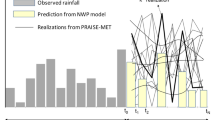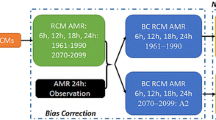Abstract
The study of climate change adaptation plans for drainage infrastructure in a small country as that of Singapore, rainfall projections on the time scale of minutes and on the spatial scales of 1 km are deemed appropriate In this paper, we introduce an application of radar-based stochastic downscaling for rainfall projections at high temporal and spatial resolutions. The input for stochastic model is derived from a Regional Climate Model. The sub-hourly extreme rainfall intensity derived from stochastic model outputs was validated against observed rain-gauge data over the historical period. Considering the advantage in computational efficiency of the stochastic downscaling method, thousand scenarios of rainfall projections at very high temporal and spatial resolution were generated. The implication of this approach is that, from these stochastically downscaled time series of rainfall, it is possible to study future sub-hourly extreme rainfall intensities which would be useful to address issue of flash floods/drainage systems.










Similar content being viewed by others
References
Bordoy R, Burlando P (2014) Stochastic downscaling of climate model precipitation outputs in orographically complex regions: 2. Downscaling methodology. Water Resour Res 50(1):562–579
Bowler NE, Pierce CE, Seed AW (2006) Steps: a probabilistic precipitation forecasting scheme which merges an extrapolation nowcast with downscaled nwp. Q J R Meteorol Soc 132(620):2127–2156
Burlando P, Rosso R (2002) Effects of transient climate change on basin hydrology. 1. Precipitation scenarios for the Arno River, central Italy. Hydrol Processes 16(6):1151–1175
Dee et al (2011) The ERA-interim reanalysis: configuration and performance of the data assimilation system. Quar J of R Met Soc 137(656):553–597
Huffman GJ, Adler RF, Bolvin DT, Gu G, Nelkin EJ, Bowman KP, Hong Y, Stocker EF, Wolff DB (2007) The TRMM multi-satellite precipitation analysis: Quasi-global, multi-year, combined-sensor precipitation estimates at fine scale. J Hydrometeorol 8:38–55. https://doi.org/10.1175/JHM560.1
IPCC (2001) Climate change 2001: the scientific basis. In: Houghton JT, Ding Y, Griggs DJ, Noguer M, van der Linden PJ, Dai X, Maskell K, Johnson CA (eds) Contribution of working group I to the third assessment report of the intergovernmental panel on climate change. Cambridge University Press, Cambridge, United Kingdom and New York, NY, USA, p 881
Jakob D, Seed AW et al (2014) Spatio-temporal characteristics of blended radar/gauge data and the estimation of design rainfalls. In: Hydrology and water resources symposium, Engineers Australia
Menabde M, Harris D, Seed AW, Austin G, Stow D (1997a) Multiscaling properties of rainfall and bounded random cascades. Water Resour Res 33(12):2823–2830
Menabde M, Seed AW, Harris D, Austin G (1997b) Self-similar random fields and rainfall simulation. J Geophys Res 102(D12):13509–13515
Menabde M, Seed AW, Harris D, Austin G (1999) Multiaffine random field model of rainfall. Water Resour Res 35(2):509–514
Niemi TJ, Guillaume JH, Kokkonen T, Hoang TM, Seed AW (2016) Role of spatial anisotropy in design storm generation: experiment and interpretation. Water Resour Res 52:69–89
Raut B, Fuente L, Seed AW, Jakob C, Reeder MJ (2012) Application of a space-time stochastic model for downscaling future rainfall projections. In: Hydrology and water resources symposium, Engineers Australia
Seed AW, Srikanthan R, Menabde M (1999) A space and time model for design storm rainfall. J Geophys Res 104(D24):31623–31630
Seed AW, Draper C, Srikanthan R, Menabde M (2000) A multiplicative broken-line model for time series of mean areal rainfall. Water Resour Res 36(8):2395–2399
Seed AW, Pierce CE, Norman K (2013) Formulation and evaluation of a scale decomposition-based stochastic precipitation nowcast scheme. Water Resour Res 49(10):6624–6641
Seed AW, Jordan P, Pierce C, Leonard M, Nathan R, Kordomenidi E et al (2014) Stochastic simulation of space-time rainfall patterns for the brisbane river catchment. In: Hydrology and water resources symposium, Engineers Australia
Skamarock WC et al (2008) A description of the advanced research WRF Version 3. NCAR Technical Notes, NCAR/TN-4751STR
Vu MT, Raghavan SV, Liong SY (2018) Constructing short-duration IDF curves using coupled dynamical–statistical approach to assess climate change impacts. Int J of Clim 38(6):2662–2671
Wilks DS, Wilby RL (1999) The weather generation game: a review of stochastic weather models. Progress Phys Geogr 23(3):329–357
Acknowledgements
We wish to thank Dr. Bhupendra Raut, formerly, Monash University and Dr. Alan Seed, Bureau of Meteorology, Australia, for their advice and guidance in the application of the HiDRUS model. We also thank the Public Utilities Board (PUB), Singapore, for providing the research grant towards investigating the impacts of extreme rainfall on drainage designs, under which this study was performed. We thank the Centre of Climate Research Singapore (CCRS) for providing us with the radar data and the station rainfall data for this study.
Author information
Authors and Affiliations
Corresponding author
Additional information
Publisher's Note
Springer Nature remains neutral with regard to jurisdictional claims in published maps and institutional affiliations.
Rights and permissions
About this article
Cite this article
Nguyen, N.S., Liu, J., Raghavan, S.V. et al. Deriving high spatiotemporal rainfall information over Singapore through dynamic-stochastic modelling using ‘HiDRUS’. Stoch Environ Res Risk Assess 35, 1453–1462 (2021). https://doi.org/10.1007/s00477-020-01912-y
Accepted:
Published:
Issue Date:
DOI: https://doi.org/10.1007/s00477-020-01912-y




